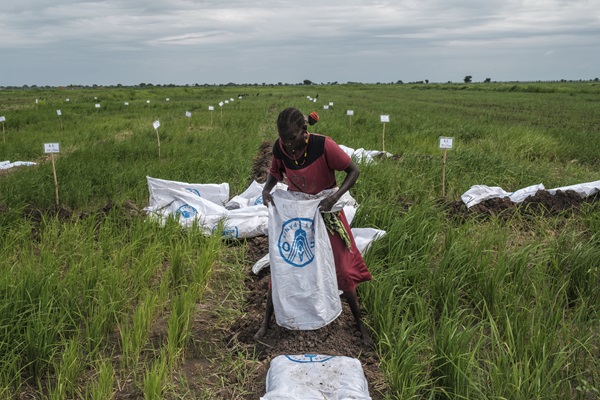
Juba/Rome – Amid the visit of the heads of the UN Rome-based Agencies (FAO, WFP and IFAD) to South Sudan, the Food and Agriculture Organization of the United Nations (FAO) is intensifying efforts to increase resilience of the country’s agrifood systems to shocks and crises and reduce its dependency from food imports and external assistance, as hunger and malnutrition continue to rise nationally.
The dire food insecurity situation in South Sudan is driven by the cumulative effects of climate shocks, particularly floods and dry spells, poor agriculture infrastructure, conflict and economic downturns. They affect agriculture production and productivity, disrupt livelihoods and hamper humanitarian access.
This is exacerbated by a continued currency depreciation and the price inflation of food and other essential commodities, mainly due to the exacerbation of food prices as a result of COVID-19 and the war in Ukraine, and the recent crisis in Sudan, which has affected markets and caused influx of refugees and returnees.
According to the latest Integrated Food Security Phase analysis, severe food insecurity is affecting over half of the population, with 7.76 million people (almost 63 percent of the country’s population) likely to face Crisis (IPC Phase 3) or worse acute food insecurity, including an estimated 43 000 people likely to face Catastrophe (IPC Phase 5) acute food insecurity.
To reverse this trend, FAO is focusing its efforts on building resilient, inclusive and self-sufficient agrifood systems. Through the Emergency and Livelihood Support programme, FAO has managed to reach an average of 400 000 households annually assisting them with seeds and tools that have helped farmers to produce 5.3 months equivalent of cereal requirement per household, whereas fishing kits provide up to 7 kg of fish per day. In addition, FAO protects around 4.1 million livestock annually through vaccination and other treatment.
“We remain committed to ensuring that no one goes to bed hungry and food security improves significantly in the country. To this end, South Sudan has to be assisted to fully exploit its vast potential in agriculture, livestock and fisheries to move away from food dependency to self-sufficiency,” said Meshack Malo, FAO South Sudan Country Representative.
In their official visit to South Sudan this week, the Director-General of FAO, QU Dongyu, the President of the International Fund for Agricultural Development (IFAD), Alvaro Lario, and the Executive Director of the World Food Programme (WFP), Cindy McCain, met with top government officials and visited vulnerable communities calling for greater investments in the country’s agricultural sector to avoid a catastrophic food crisis.
FAO’s key priorities
FAO has developed a Country Programming Framework (CPF) for 2023-2025, which identifies key FAO South Sudan priority areas, current programmes and successes to date. Such priorities include enhancing evidence policy, strategic and institutional frameworks for agriculture, fisheries, forestry, food and nutrition security, institutional support, and strengthening capacities of farmer organizations.
Under the World Bank and African Development Bank funded projects, FAO is supporting and strengthening government institutions from national to subnational level through production of training material, mobility of research and extension staff, construction of seed and entomology laboratories, communication and surveillance systems.
Under the Localization Agenda, FAO has been at the forefront in training national non-governmental organizations (NGOs) in project management, financial management and reporting.
Another important area is increasing sustainable agricultural production and productivity in the country. Through the various development projects and support to Farmer Organizations, FAO has provided training in Good Agricultural Practices (GAP) including Climate Smart Agriculture and Integrated Pest Management Practices. Some farmers, for example, in the Western Equatorial State, have managed to sell excess to the WFP local purchase programme.
FAO has supported more than 2 000 seed groups in seed production producing around 2 000 tonnes of seed that have found their way into local seed companies and FAO organized seed fairs. Likewise, training in fish post-harvest management and introduction of efficient fish processing techniques has helped fishers and processors, mainly women, to reach local and regional markets.
Through the Hand-in-Hand initiative FAO supports the government investment plan in three value chains – fish, sesame and sorghum.
Furthermore, FAO is piloting modernization and digital transformation of agrifood systems through an E-Registry Core Platform to be linked to E-trading; seed assessment; E-extension and weather advisory; Production monitoring; and Digital financial services.
The CPF for a total of $270 million is 50 percent underfunded with the funding gap currently amounting to $138 million.
New FAO funding for South Sudan announced
FAO has just announced an additional funding worth $500 000 for timely, strategic emergency agricultural assistance to people in South Sudan affected by the crisis in Sudan and for the HiH platform.
The $300 000 for emergency livelihood assistance will reach 10 000 returnees, newly displaced populations and host communities affected by the crisis in Sudan. FAO will procure and distribute crop seeds to 6 000 households, vegetable kits to 5 000 households and fishing kits to another 5 000 households.
The $200 000 HiH funding will contribute to government priorities of sustainable economic growth and diversification by supporting country-led programmes. With this funding, FAO will support ten governmental researchers as well as 1 000 farmers and 500 fishers to build knowledge and skills in sorghum and sesame production, including soil and water management practices and fisheries, post-harvest handling and preservation.